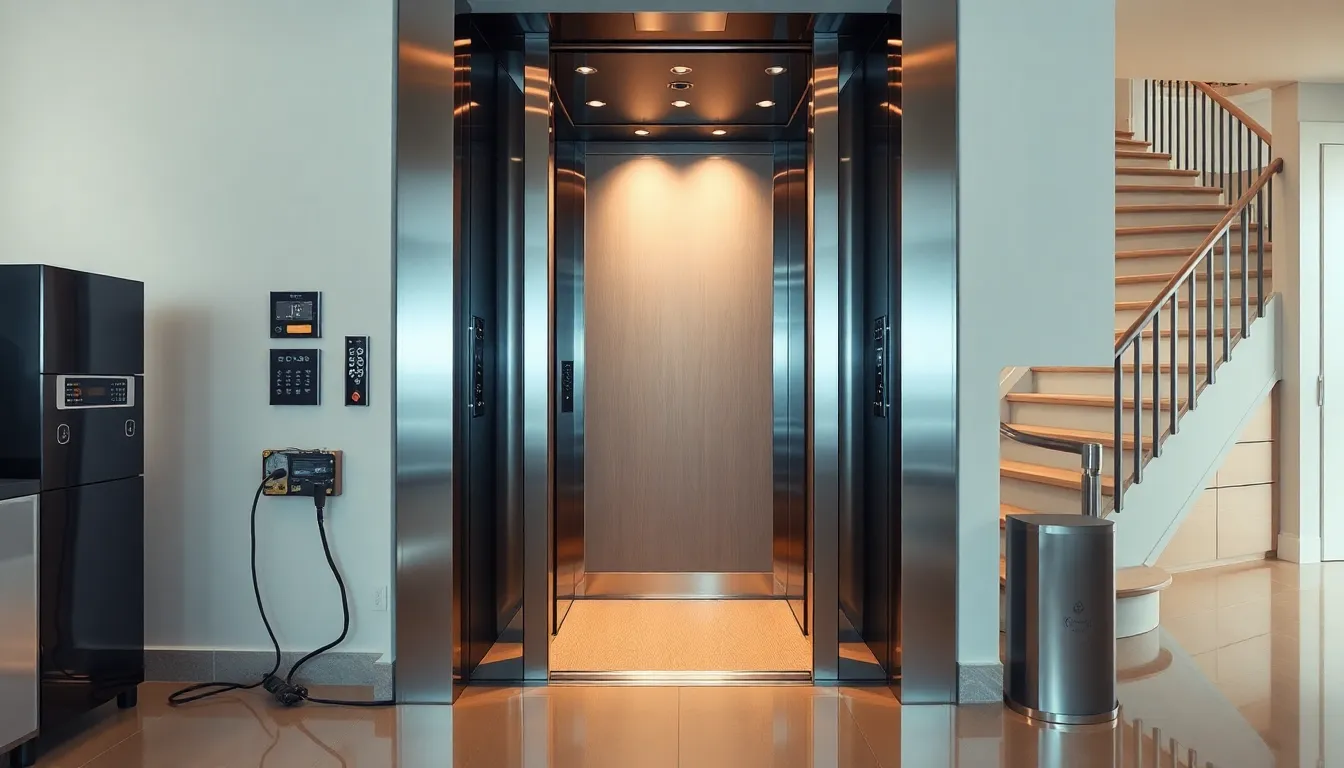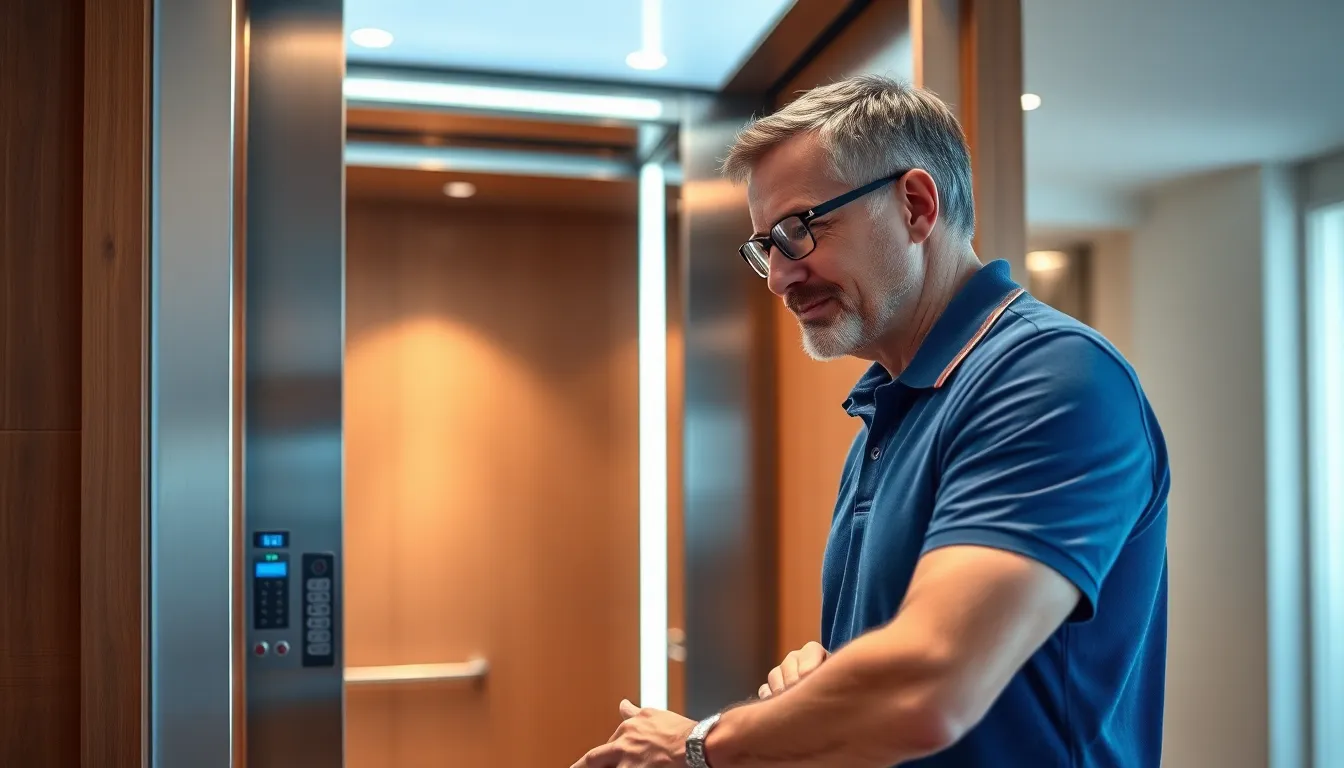Home elevators can be a game-changer, transforming a multi-story house into a seamless experience. But like any hero, they need a little TLC to keep saving the day. Ignoring maintenance can lead to unexpected hiccups and costly repairs that’ll have you wishing you’d paid more attention to that little button labeled “service.”
Table of Contents
ToggleImportance of Home Elevator Maintenance
Regular maintenance of home elevators ensures safety and reliability. Elevators experience daily use, leading to wear and tear. Without consistent check-ups, minor issues can escalate into significant problems, resulting in costly repairs.
Homeowners benefit from scheduled inspections that catch potential malfunctions early. Professional technicians evaluate vital components such as cables, pulleys, and brakes. This assessment helps maintain optimal performance and prolongs the elevator’s lifespan.
Infrequent maintenance can lead to decreased efficiency. When elevators operate smoothly, energy consumption remains lower, contributing to reduced utility costs. Additionally, a well-maintained elevator enhances property value, appealing to potential buyers.
Safety concerns arise with neglected elevators. Regular servicing significantly reduces the likelihood of accidents, ensuring that users feel secure while operating the lift. Homeowners prioritize the well-being of their family and guests, making maintenance critical.
Documentation is essential during maintenance. Keeping detailed records of inspections and repairs helps track the elevator’s history. These records provide valuable information for future servicing and enable technicians to identify recurring issues.
Investment in maintenance translates to peace of mind. Knowing that the home elevator functions correctly allows homeowners to focus on their daily activities without worry. A proactive approach to maintenance offers numerous advantages, emphasizing its importance in home elevator care.
Common Home Elevator Issues

Home elevators can experience various issues that affect their performance. Recognizing these problems early leads to efficient maintenance and prevents expensive repairs.
Unusual Noises
Hearing unusual noises from a home elevator points to underlying mechanical issues. Grinding sounds may indicate worn components, while squeaks suggest misalignment. Ignoring these noises can result in further damage or malfunction. Regular inspections help identify problems before they escalate. Homeowners should report these sounds immediately to qualified technicians to ensure prompt attention.
Slow Operation
Slow operation in a home elevator disrupts the convenience it provides. This sluggishness often arises from issues with the motor or drive system. Hydraulic systems may require fluid checks to ensure optimal function, while cable-operated models might need cable lubrication. Addressing slow operation quickly maintains the elevator’s efficiency and reliability. Regular maintenance checks can keep the system running smoothly, enhancing overall user experience.
Regular Maintenance Practices
Regular maintenance practices are essential in ensuring the safety and efficiency of home elevators. Routine inspections can identify and address issues early, prolonging the elevator’s lifespan.
Lubrication of Moving Parts
Lubrication of moving parts is crucial for smooth operation. Applying the right lubricant reduces friction, preventing wear during daily use. Technicians should focus on components such as cables, pulleys, and rollers. Schedule lubrication every six months or more frequently if the elevator experiences heavy use. Greasing these parts extends their life and enhances performance, making the ride more pleasant for users.
Checking Safety Features
Checking safety features ensures users stay safe while using the elevator. Evaluating emergency brakes, door sensors, and backup systems is vital during regular inspections. Technicians must verify that these features function properly without any obstructions. They should perform tests and document results to maintain compliance with safety standards. Inspecting these features periodically alleviates potential hazards and boosts user confidence in the system.
Professional Maintenance Services
Engaging professional maintenance services ensures optimal performance and longevity for home elevators. Regular inspections from experienced technicians can identify issues before they escalate, promoting safety and reliability.
When to Hire a Professional
Homeowners should hire a professional if they notice unusual noises or experience slow operation. Professional assistance is crucial during scheduled inspections, typically recommended twice a year. Technicians can perform safety checks on systems like emergency brakes and door sensors. If an elevator fails to respond correctly to commands, calling an expert immediately can prevent further complications. Timely intervention by professionals helps maintain compliance with safety standards, enhancing user confidence. Regular maintenance not only addresses immediate concerns but also improves overall efficiency and performance.
Cost of Professional Services
Costs for professional home elevator maintenance vary based on service complexity and location. Average fees for routine inspections range from $100 to $300, depending on the technician’s expertise and specific tasks performed. Emergency repairs tend to be more expensive, with charges often exceeding $500. Budgeting for regular maintenance can prevent costly repairs long-term. Homeowners should also consider the potential increase in property value associated with a well-maintained elevator. Investing in proper services ensures safety and reliability, providing peace of mind for any residential setting.
DIY Maintenance Tips
Homeowners can perform several maintenance tasks to keep their elevators running smoothly. Inspecting the cabin for dirt and debris regularly enhances hygiene and safety. A simple vacuuming session helps maintain a clean environment while ensuring that the door tracks remain unobstructed.
Lubrication of moving parts contributes to optimal functionality. Applying high-quality lubricant every six months promotes smooth operation. Increased usage may necessitate more frequent applications to prevent wear and tear.
Regularly monitoring the control panel for functionality is essential. Checking buttons for responsiveness ensures that the elevator operates efficiently. A quick inspection can identify any irregularities early, reducing potential downtime.
Testing safety features is a vital aspect of DIY maintenance. Homeowners should periodically check emergency brakes and door sensors. These components ensure user safety during operation, contributing to peace of mind.
Inspecting emergency communication systems maintains safety standards. Testing intercom connections guarantees they function properly in emergencies. Attention to these details helps ensure that people can communicate when needed.
Cleaning the elevator’s exterior regularly enhances aesthetic appeal. Using appropriate cleaners prevents damage to surfaces while providing a polished look. Routine care not only improves appearance but can also prolong the elevator’s lifespan.
Maintaining detailed records of DIY tasks helps track maintenance efforts. Documenting inspections and repairs simplifies future servicing by providing a maintenance history. Such organization supports proactive care, enhancing overall elevator performance.
Regular maintenance of home elevators is crucial for ensuring safety and efficiency. By prioritizing scheduled inspections and addressing issues promptly homeowners can avoid costly repairs and enhance the overall user experience.
Engaging professional services for routine checks and being proactive with DIY maintenance tasks empowers homeowners to keep their elevators in top condition. This not only prolongs the elevator’s lifespan but also contributes to increased property value.
Ultimately a well-maintained home elevator offers convenience and peace of mind making it an invaluable addition to any multi-story residence.



